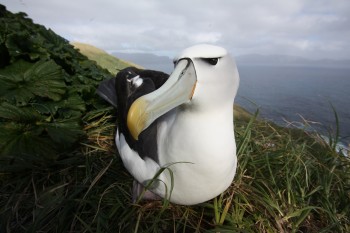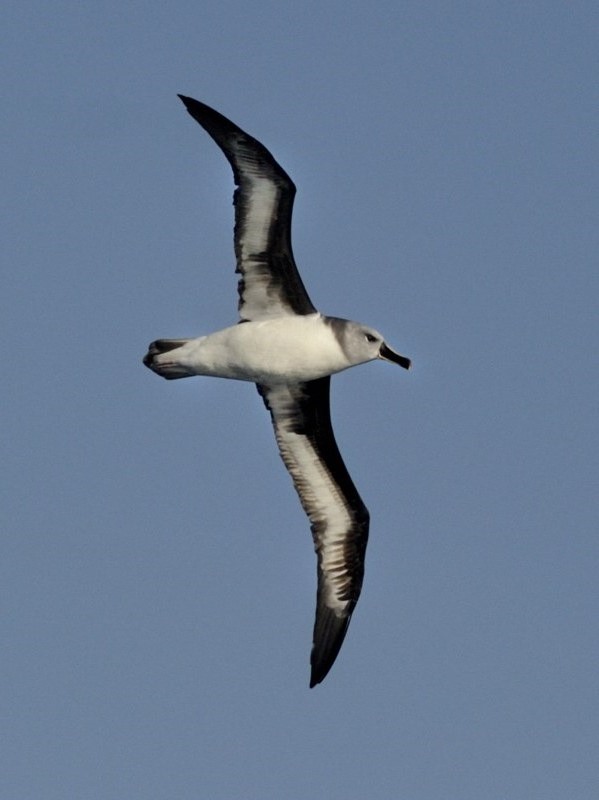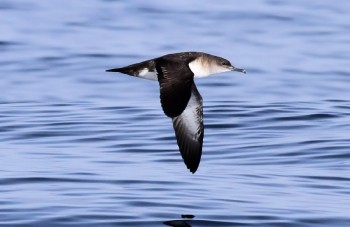Barry Baker (Latitude 42 Environmental Consultants, Kettering, Tasmania, Australia) and colleagues have submitted a draft report to the Conservation Services Programme (CSP) of NewZealand’s Department of Conservation that gives the results of aerial surveys of White-capped Albatrosses Thalassarche steadi on the Auckland Islands south of New Zealand.
The report’s Executive Summary follows:
“White-capped albatrosses Thalassarche steadi are endemic to New Zealand, breeding on Disappointment Island, Adams Island and Auckland Island in the Auckland Island group, and Bollons Island (50-100 pairs) in the Antipodes Island Group (Gales, 1998). Previous population estimates that we have developed (Baker et al. 2014) show that most (95%) of the global population breeds on Disappointment Island, an area where access is restricted to maintain environmental values at the site.
Between 2006/07 and 2014/15 (hereinafter 2006 and 2014, respectively) we undertook repeated population censuses of the white-capped albatrosses breeding in the Auckland Islands using aerial photography. These population censuses were carried out in either December or January each year to estimate population size and track population trends. Our measure of population size was ‘Annual breeding pairs’, defined as any pair of albatrosses that lays an egg in the breeding season of interest. All other birds in colonies were assessed as ‘Loafers’, defined as birds present in a colony but which do not appear to be associated with an active nest at the time of observation.
In 2014 we estimated that there were 96,864 (95%CI 96,242 — 97,486), 4,741 (4,603 — 4,879) and 193 (165— 221) annual breeding pairs at Disappointment Island, South West Cape and Adams Island, respectively, in 2014, based on the raw counts, giving a total for these sites of 101,798 (101,160 — 102,436) breeding pairs. Based on an assessment of 15 aerial close-up photos, 5.8% of birds in the colonies were loafers. After adjusting the raw counts to account for loafing birds, we estimate that there were 95,894 annual breeding pairs in the Auckland Islands in 2014. Previous annual counts have ranged from 73,838 to 116,025 annual breeding pairs (mean 90,781 annual breeding pairs).
Ground counts undertaken by Thompson et al. (2015) in January 2015, a few days before the 2014 aerial counts were undertaken, showed that of 1,127 birds sitting on nests, 909 (81%) were incubating eggs and 218 birds (19%) were sitting on empty nests. These data can be compared with ground counts of nests taken earlier in the breeding season (December) in 2008 that showed that 93.5% contained eggs and only 6.5% were empty. Aerial counts undertaken earlier in the breeding season are likely to provide a more accurate estimate of annual breeding pairs as nest failures occur progressively throughout the breeding season once egg laying has been completed. Ground-truthing data assessing the proportion of birds sitting on empty nests will not reliably provide a correction factor relevant to determining annual breeding pairs, as a bird sitting on an empty nest may have laid and subsequently lost its egg, may be yet to lay, or simply be a non-breeding loafer.
Count data over nine years show strong inter-annual fluctuations, a characteristic we have observed for many other seabird species. This variability would encompass counting error, the presence of non-breeding birds during counts, environmental stochasticity and other unknown variables that are not easily quantified. Trend analysis of nine years of counts using regression splines showed no clear evidence for systematic increase or decline over the nine years of the study. Given this we do not have sufficient evidence to reject the null hypothesis of no systematic trend in the total population. The trend should be considered to be uncertain; however, the null hypothesis of a stable population remains tenable and is probably a reasonable interpretation.”
With thanks to Barry Baker for information.

White-capped Albatross, photograph by Graham Parker
Reference:
Baker, G.B., Jensz, K., Cunningham, R., Holdsworth, M. & Chilvers, B.L. 2015. White-capped Albatross Aerial Survey 2015 Draft Final Report. Report prepared for Department of Conservation Contract 4625. [Kettering]: Latitude 42 Environmental Consultants. 20 pp.
John Cooper, ACAP Information Officer, 12 November 2015

 English
English  Français
Français  Español
Español 


